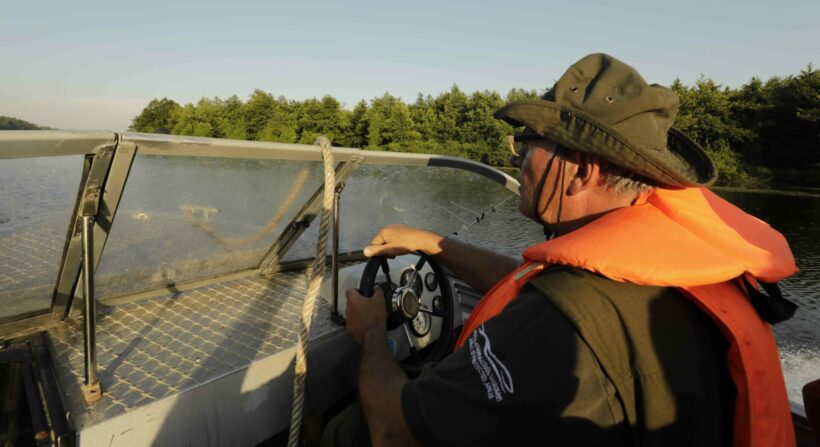The first-ever study of its kind stresses that earnings of natural park staff must increase for the health of life on Earth
Governments around the world have come together to potentially commit to protect 30% of the planet’s wild lands by 2030. The project, also called ‘30 by 30”, is the result of a new study that revealed the intense lack of rangers and other staff to effectively manage even the current protected and conserved areas.
The paper, published on Oct. 20, 2022 in Nature Sustainability urges governments, donors, private landowners, and NGOs to increase the numbers of rangers and other staff by five-fold to meet global goals for economic, cultural, spiritual, and ecosystem benefits.
“Our protected areas system is the life support of the planet, providing people with water and clean air, storing carbon and preventing biodiversity loss,” said Mike Appleton, Re:wild’s director of protected area management and lead author of the paper. “Yet there are more people employed at golf courses and country clubs in the United States than there are rangers in the world. The 30 by 30 target is an important goal, but meaningless if we aren’t also willing to invest in people to effectively and equitably manage these places.”
“Analyzing the data was challenging, exciting, but also depressing. Our results have revealed the deplorable inadequacy of the current situation. But the good news is that we have established a baseline from which to move forwards,” said Alexandre Courtiol (coauthor), Leibniz Institute for Zoo and Wildlife Research.
Using data from 176 countries and territories, the study estimates that there are only 555,000 protected area personnel* worldwide who are responsible for 17% of the world’s land surface (over 20 million square kilometers or 7.7 million square miles).
Protected area personnel includes individuals who spend at least 50% of their time managing protected areas. Rangers, a subset of protected area personnel, are “involved in the practical protection and preservation of all aspects of wild areas, historical and cultural sites.”
There are only 286,000 rangers, who directly manage protected areas, uphold laws, work with visitors and local communities, and monitor wildlife. Rangers also act as tour guides, firefighters, and environmental defenders, among other roles.

Female ranger Miyeko has a hand up with a young child while she swears the child in for her junior ranger badge.
Yellowstone National Park. Wikimedia Commons.
“Rangers manage our protected and conserved areas without the necessary support to do their jobs safely. These individuals are, in many cases, putting their life at risk so that the rest of us can enjoy fresh air, fresh water, and a healthy planet. To maintain the motivation of the current workforce, ensure their professionalism, and attract the new people needed, we have to address these issues and provide these individuals with the recognition and resources they need and deserve,” said Mónica Álvarez Malvido (coauthor), development officer, International Ranger Federation
Examples of protected areas include national parks, nature reserves, landscape reserves, natural monuments, state parks, and certain areas under sustainable indigenous and traditional management.
To obtain the “30 by 30” plan, a workforce of at least 2.9 million people, including 1.53 million more rangers are needed. Alongside government-protected areas, many new types of areas will need to be conserved by personnel in the private and nonprofit sectors and, vitally, by indigenous and local communities managing their own territories.
This is the first estimate of the global number of protected area personnel since 1999 and the first ever to specifically include rangers. The study was led by a collaboration between Re:wild, the IUCN World Commission on Protected Areas, the Leibniz Institute of Zoo and Wildlife, WWF, the Game Rangers Association of Africa, the International Ranger Federation, and the Ranger Federation of Asia.
“This critical work is timely as our continued existence on this planet is becoming increasingly fragile because of the human-induced crises, climate change, and biodiversity loss,” said Madhu Rao, chair of the IUCN World Commission on Protected Areas. “For any country or region to stand a chance of attaining the ambitious global targets that are being set to mitigate these detrimental effects, there needs to be a significant investment in the people tasked with securing wildlife, natural ecosystems, natural resources, and the communities and cultures that have sustained them for millennia. For ambitious global targets to be meaningful and effective, we need more committed, competent, and well-supported personnel on the ground.”
The study also emphasizes the need not only to bolster the workforce but to recognize protected area management as a vital professional service, similar to medical personnel and first responders. Other studies have shown that protected area personnel in many countries are underpaid, undersupported, undertrained, and endure inadequate working conditions.
To address this issue, a coalition called the Universal Ranger Support Alliance (URSA) is working to implement an action plan to ensure that rangers have better working conditions and equipment, more opportunities for training and learning, fairer employment opportunities and conditions, and better representation, advocacy, and accountability.
“The effectiveness of the planet’s life support system isn’t just about numbers of hectares protected, but about investing in good and skilled people,” said Chris Galliers, president of the International Ranger Federation. “While we are working hard to ensure that our global ranger workforce is more representative, professional, and accountable, they need far greater capacity and support as respected stewards of our wildlife and wild places. Rangers can and do play a key role in reducing the threats to the territories and livelihoods of local and indigenous communities, including mitigating the effects of climate change. However, a firm commitment that puts rangers central to achieving any global targets is urgently required.”
“The world needs rangers–to protect biodiversity, to maintain essential ecosystem services, to make sure that wilderness areas stay wild. Our findings should serve as a wake-up call for the world. It is essential that we scale up the ranger workforce to ensure the health of protected areas worldwide,” said Andrew Tilker (coauthor), Asian species officer at Re:wild and also part-time post-doc at the Leibniz Institute for Zoo and Wildlife Research.

Wercklea flower. Grand Bois National Park. Haiti’s first private nature reserve. Wikimedia Commons.
In addition to protecting biodiversity and cultures, protected area personnel sustain vital ecosystem services, and deliver substantial economic benefits to local people and to the wider economy. According to the study, each new protected area staff person could generate economic benefits worth at least USD$28,800.
“Society needs to recognize the vast economic benefits that protected areas bring to communities, economies, and our living planet,” said Wes Sechrest, chief scientist and CEO of Re:wild. “When we do so, we can pay the modest costs of employing and supporting people to protect our planet, communities can benefit from the areas they steward, and countries can move quickly toward nature-positive and sustainable environmental practices.”
Re:wild, FFI, IRF, IUCN-WCPA and WWF are members of the Universal Ranger Support Alliance (URSA).
The 15th meeting of the Conference of the Parties to the Convention on Biological Diversity will be held this year in Montreal, Canada, from Dec. 7 to Dec. 15. CBD provides a global legal framework for action on biodiversity.










